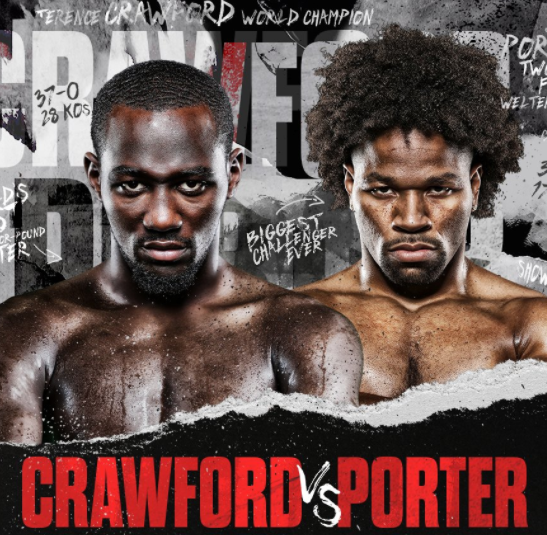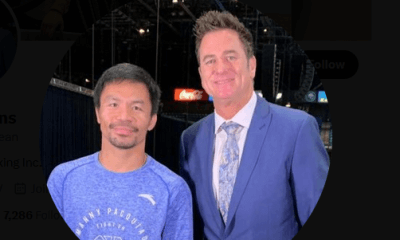Featured Articles
Shawn Porter is a Wrecking Ball with a Grade-A Chin, but the Pick is Crawford

Terence Crawford will finally have a chance to reshape the narrative of his (so far) middling stint in the welterweight ranks when he defends his 147-pound bauble against the redoubtable Shawn Porter Saturday night at the Mandalay Bay Resort & Casino in Las Vegas. Who knows, if the end result swings in his favor – and it should – you may even see the surly switch-hitter break into a smile.
Ever since he hiked up to the so-called glamour division some four odd years ago, Omaha’s Crawford has reaped seemingly every desirable outcome an elite prizefighter could dream of from the sport: outsize paychecks (cut by his longtime promoter Top Rank), exposure on national television (via media mammoth ESPN), and nonstop adulation as a generational great (according to Joe Tessitore and anyone with a Twitter handle). So why all the sulking?
Because for every ditty sung in praise of Crawford’s “pound-for-pound” bonafides, a barrage of jeers rains down from the peanut gallery, calling into question his credentials at the welterweight limit – and rightfully so. His white whale, Errol Spence Jr., has remained beyond reach, on account of the ceaseless factional rifts in the sport. Manny Pacquiao has retired (for now) to become a fulltime politico. That Crawford’s run thus far at 147 has been underwhelming is an understatement. His first fight in the division, after all, was a title shot against the tough-as-nails but cloddish Jeff Horn, a former school teacher. The matchmaking did not improve. Jose Benavidez Jr., Amir Khan, and Kell Brook were all, to one degree or another, hobbled and shopworn. Only Egidijus Kavaliauskas, a solid contender who managed to give Crawford a few fits in the early going before folding late, can be said to have been in his prime. Indeed, the disjunction between the prestige of his name and the inadequacy of his résumé can only be the source of much frustration, if not outright embarrassment, for a fighter as prideful as Crawford. Nobody in boxing, not even a palooka, wants to hear that their career is a sham.
The recent achievement of Canelo Alvarez, who unified all four belts in the 168-pound division with a stoppage over Caleb Plant earlier this month, serves as an instructive foil. Even Crawford, 34, seemed to be in awe of Alvarez’s latest milestone, his recent comments suggesting a whiff of envy.
“[Alvarez] has fought four times in the past year,” Crawford told Sky Sports. “He has become undisputed. He is getting all of the fights that he wants right now. Unfortunately, I haven’t been able to. It has been frustrating. But what’s meant for me, I will have. Everything happens for a reason and I believe that my time is coming. I feel like I’m already there, but I have to prove it to the world and it starts with Porter.”
Although Crawford has described Porter in ways that suggest he views him as nothing more than a steppingstone – “I told him I’m not looking to fight you,” Crawford recounted to Tim Bradley. “I’m looking to fight Spence, I’m looking to fight Keith Thurman, because they’ve got something to offer.” – the mauler from Cleveland, Ohio is clearly the toughest opponent of his career. A former football player, Porter is a wrecking ball in perpetual motion. Few willingly line up to face Porter, and those who have faced him are never in the mood for a rematch. “[It’s like] skydiving for the first time,” Kenny Porter said of his son recently. “When you get to the ground and you’re safe, you say, ‘whew, I made it. I’m never doing that again.’ That’s Shawn Porter. That’s what you get.”
In recent years, Porter has added a bit more finesse to his pedal-to-the-metal approach, in addition to shoring up some of the more unsavory aspects of his aggressive style, namely his tendency to smother his punches, utilize elbows, and lead with his head. In what may have been the best performance of his career (albeit in a losing effort) against Spence, Porter landed a surprising number of clean, strafing blows. But his worst habits came back to haunt him late, when Spence caught him waffling on the inside, chin exposed, with a left cross that put him down. To his credit, Porter, 31-3-1, (17), was not visibly shaken. Nevertheless, such lapses figure to be a recipe for disaster against a marksman as accurate and lethal as Crawford. Still, compared to previous Crawford victims, Porter is durable, superbly conditioned, and perhaps most importantly, he has an A-grade chin.
Unlike Porter, Crawford does not have any glaring weaknesses. He hits hard with both hands, can switch stances on a dime, and possesses, like the best jazz artists, an improvisatory feel for the game. He can also take a punch. What makes Crawford especially unique in boxing today though is his ability to finish. He has stopped every single welterweight he has ever fought, a feat worth mentioning given that is not an inclination shared by some of his top peers; Thurman has gone the distance with Josesito Lopez, Danny Garcia with Ivan Redkach, and Spence with an undersized Mikey Garcia. The last time Crawford, 37-0 (28), went the distance was in 2016, when he defeated Viktor Postol on points. Porter, of course, is an entirely different proposition. Moreover, one concern for Crawford is that he seems to be more hittable in recent fights. Against Brook, Crawford had trouble avoiding the jab; against Kavaliauskas, he ate his fair share of right hands. On the other hand, Crawford will not have to worry about being presented with those same problems by Porter, whose strengths are of the more rough-hewn variety.
In order to have his hands raised at the end of the night, Porter must fight according to his natural instincts and employ the same gung-ho tactics that he used against Spence. Trying to be a cutie, as he imprudently did against Yordenis Ugas, is not the answer here. Yet he is up against an opponent who excels at containing pressure fighters and countering their aggression. That is why it is doubly important that Porter win the early rounds and take advantage of the fact that Crawford typically starts slow. The path for Porter to win is on the judges’ scorecards.
Crawford, on the other hand, needs to take a page out of the playback he employed for Horn. That means fighting exclusively out of the southpaw stance, doubling up the jab, and snapping off hooks while simultaneously circling away to his right. Eventually, Crawford will mix in uppercuts and find a home for his straight left. Unless Crawford, no spring chicken, has diminished considerably, it is hard to envision him squandering this opportunity. By the late rounds, Porter should be ready to go. Expect a violent finish – and perhaps even a smile…. CRAWFORD TKO 11
Check out more boxing news on video at the Boxing Channel
To comment on this story in the Fight Forum CLICK HERE
-

 Featured Articles3 weeks ago
Featured Articles3 weeks agoVito Mielnicki Jr Whitewashes Kamil Gardzielik Before the Home Folks in Newark
-

 Featured Articles4 days ago
Featured Articles4 days agoResults and Recaps from New York Where Taylor Edged Serrano Once Again
-

 Featured Articles1 week ago
Featured Articles1 week agoFrom a Sympathetic Figure to a Pariah: The Travails of Julio Cesar Chavez Jr
-

 Featured Articles3 days ago
Featured Articles3 days agoResults and Recaps from NYC where Hamzah Sheeraz was Spectacular
-

 Featured Articles4 weeks ago
Featured Articles4 weeks agoCatching Up with Clay Moyle Who Talks About His Massive Collection of Boxing Books
-

 Featured Articles1 week ago
Featured Articles1 week agoCatterall vs Eubank Ends Prematurely; Catterall Wins a Technical Decision
-

 Featured Articles4 days ago
Featured Articles4 days agoPhiladelphia Welterweight Gil Turner, a Phenom, Now Rests in an Unmarked Grave
-

 Featured Articles3 weeks ago
Featured Articles3 weeks agoMore Medals for Hawaii’s Patricio Family at the USA Boxing Summer Festival



















